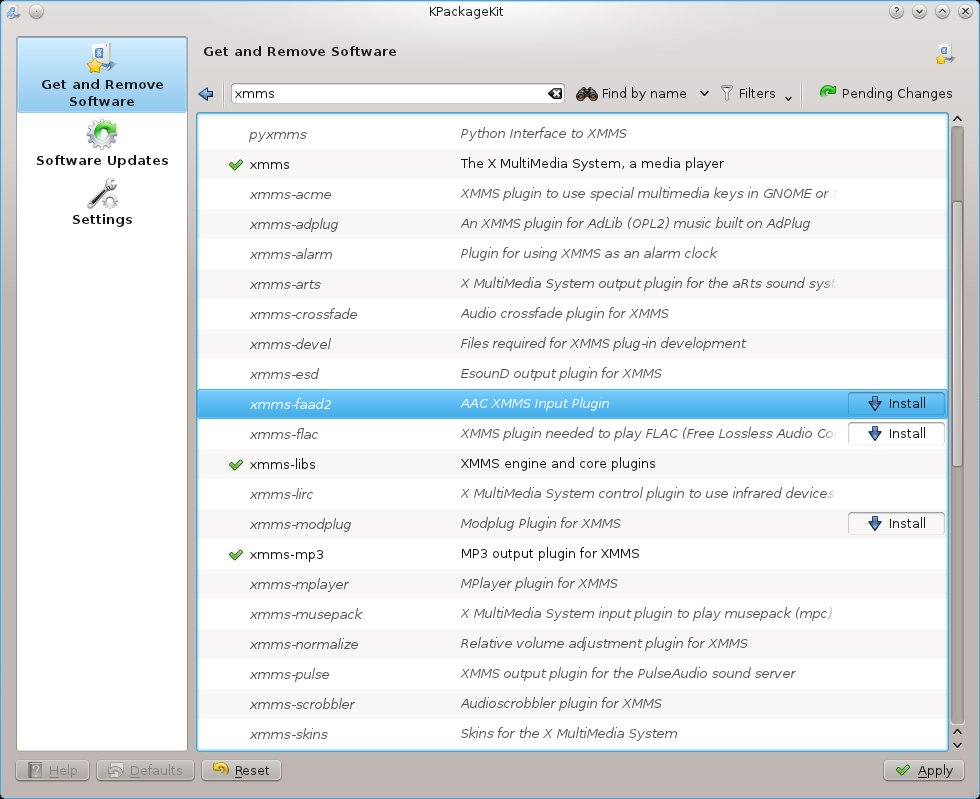
Installing and managing software on Fedora Core Linux is very easy.
Installing packages. yum install .
Upgrade a package. yum upgrade .
Uninstall a package. yum remove .
You may also use the rpm command to install an RPM package that you have downloaded off the Internet.
rpm -ivh To install a rpm package.
rpm -Uvh To upgrade an installed rpm package.
rpm -e This will remove an installed package.
rpm -q . To query the version of an installed package.
rpm -ql . To list all the files installed by an RPM package.
Sometimes when installing a rpm package you have downloaded from the Internet there are unmet dependencies. In this case you will need to source the required RPM packages and then try the installation again. if you create a folder containing all the required RPM packages, then you could type rpm -ivh *.rpm and they will all be installed. The image to the right shows the KPackageKit package manager GUI. You can see the packages I have selected for installation.
The Xmms multimedia player is a very old and very good music player and I am adding Modplug and AAC plugins for that music player to enhance the application. The Gnome package manager is very similar and just as easy to use as the KDE package manager. You just type the name of the package you are after and click find.
Installing the non-free repositories on Fedora Core Linux. Enabling MP3 playback and the Google repository.
To install the extra repositories on your Fedora Core Linux system, type this command.
su - yum localinstall --nogpgcheck http://download1.rpmfusion.org/free/fedora/rpmfusion-free-release-stable.noarch.rpm http://download1.rpmfusion.org/nonfree/fedora/rpmfusion-nonfree-release-stable.noarch.rpm yum update |
This will install the RPM Fusion repository. After that command has completed we then need to import the GPG key for the packages we will be installing.
su - yum install wget wget https://dl-ssl.google.com/linux/linux_signing_key.pub rpm --import linux_signing_key.pub |
Then create a file named google.repo in the /etc/yum.repos.d/ folder.
su -c "touch /etc/yum.repos.d/google.repo" |
Then inside the file add this content for a 32bit system.
[google] name=Google - i386 baseurl=http://dl.google.com/linux/rpm/stable/i386 enabled=1 gpgcheck=1 gpgkey=https://dl-ssl.google.com/linux/linux_signing_key.pub |
And this content for a 64bit system.
[google64] name=Google - x86_64 baseurl=http://dl.google.com/linux/rpm/stable/x86_64 enabled=1 gpgcheck=1 gpgkey=https://dl-ssl.google.com/linux/linux_signing_key.pub |
To install the Microsoft Fonts, this package will install the fonts if you wish to use them.
wget http://www.my-guides.net/en/images/stories/fedora12/msttcore-fonts-2.0-3.noarch.rpm && su -c 'rpm -ivh msttcore-fonts-2.0-3.noarch.rpm' |
if you have the aforementioned RPM Fusion repository enabled when you try to play your MP3 files in Totem or Rhythmbox, then the required codecs should be automatically installed by the application. But if you wish to install them manually saving some effort later then this command will install the Gstreamer codecs.
su -c 'yum install gstreamer-plugins-good gstreamer-plugins-bad gstreamer-plugins-ugly' |
The Libdvdcss library required for DVD playback is available here: http://download.videolan.org/pub/libdvdcss/1.2.9/. To install this library you need to install from source. So follow this sequence of commands and the library will be installed.
wget http://download.videolan.org/pub/libdvdcss/1.2.9/libdvdcss-1.2.9.tar.bz2 tar -jxvf libdvdcss-1.2.9.tar.bz2 cd libdvdcss-1.2.9/ ./configure --prefix=/usr make su -c "make install" |
The libraries may also be installed with the yum commmand.
su -c 'yum install libdvdread libdvdnav lsdvd' |
su - rpm -Uvh http://rpm.livna.org/livna-release.rpm yum install libdvdcss |
Source for this article: http://www.my-guides.net/en/guides/linux/240-fedora-16-post-installation-guide.
To edit a file with an easy to use text editor on Fedora Core 17, install the VIM editor with the yum install vim-X11 command. This installs a nice VIM text editor to edit various configuration files.
Fedora Core 17 multimedia setup.
Fri Aug 3 23:55:34 EST 2012.
The Fedora 17 Linux distribution, being a free community supported version of the Red Hat Enterprise Linux operating system is well worth using, I installed the latest Gnome version to replace Ubuntu 12.10 that is beset with annoying bugs that have gone unfixed for 11 days or more. Namely the inability to install packages with the package manager GUI or the conventionalapt-getcommand. That is not a good look, they really should fix that in a more timely manner, but the Ubuntu 12.10 release is a little while away and they have some more time to fix this I hope. I am using some of the commands on this webpage: http://www.sklav.com/fedora-16-multimedia-howto to install the repositories to enable the playback of non-free codecs with Fedora Core 17. Then I use these commands below.
# yum install gstreamer-plugins-ugly # yum install gstreamer-plugins-bad # yum install gstreamer-plugins-bad-extras # yum install gstreamer-ffmpeg ffmpeg smplayer # yum install libdvdcss |
Then the required plugins will be installed for Gstreamer. And a nice movie player as well. This sequence of commands was sufficient to get Xvid/MKV/MP3 support working in Fedora Core 17. The link provided for this entry, the Fedora 16 HOWTO will work with Fedora 17 as well as far as adding the actual repositories so that the installation of packages is successful. I have provided instructions above on how to build the Libdvdcss library from source if the package install does not work.
1 thought on “Fedora Core Linux package management and setup tips.”